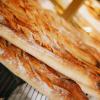
By Anna Kibbey
August 2024
Think only locals can know the trick to finding the perfect stick? Mais, non! Our cheat sheet will get you purchasing like a Parisian in five minutes flat
Born and raised in Paris, Milan Melet has been visiting the boulangerie for a daily baguette since he was tall enough to carry it. And for the past decade, he has been helping visitors get to know the city through his tours of its markets, épiceries and boulangeries on his Paris food tours, which—naturellement—always end with a picnic of the best produce. France is fanatical about food, and no more so than when it comes to the humble baguette—even legislating ingredients and language to ensure it’s the best it can possibly be. Want to know when, how and where to buy your baton? Scroll on for Melet’s ultimate explainer…

It may sound obvious, says Melet, but the best baguette “has to be from boulangerie, which means they make and bake their own bread on the premises.” If it isn’t, it is called a dépôt de pain.
“There are several other signs of quality,” Melet continues, “it is good to see the words ‘Artisan Boulanger’ attached.”
But the very best indicator is to look for the letters M.O.F., which stand for Meilleur Ouvrier de France. “It is la crème de la crème for artisans like bakers, chocolatiers, butchers, carpenters, stained-glass makers and so forth.”
“Find the closest boulangeries in your neighborhood. Parisians don’t cross town for a boulangerie—there are about 1,400 in Paris alone, so you’re never far away from a good one.”
“Fetch bread daily, or—if you keep it well (wrapped in a clean towel)—every two days. Traditionally, like at my grandparents’, there’s no waste. If it goes dry, use it for croutons for soup.”
“Go early, at around 7 a.m., to catch the first batch of fresh bread for breakfast. But they keep baking through the day so if you want fresh, warm bread for dinner, wait until 6 or 7 p.m. for the last batch before they close at 8 p.m. Ask your baker at what time they get their last batch made and ready.”

“Ask for a ‘Tradi’ (no need to add the word ‘baguette’ to it). Since the decree of 1993 to protect real bakeries, a new, higher-quality type of baguette was created, called ‘Traditionelle’ or ‘Tradi’ for the locals.
“This baguette must be made with only four ingredients—bread flour, salt, water, and yeast—and must not be frozen at any stage. The inside must be more open, more airy.
“Normal baguettes can be good, but there are no quality requirements, so they can also have additives or preservatives inside. Not the Tradi.”
“If you like your baguette almost white, with the crust barely tanned, say: ‘Bonjour, une baguette bien blanche, s’il vous plaît.’ Or, “Une baguette pas trop cuite, s’il vous plaît” (very lightly tanned). Then there is just ‘normale,’ and for a well-tanned crust (which leaves a lot of crumbs when it breaks) ask for, ‘bien cuite.’”
“Greet the vendor with a smiley ‘Bonjour’ when you arrive and ‘Merci, bonne journée. Au revoir’ on your way out. No true Parisian would enter or leave a boulangerie without a proper greeting. And never, ever jump the queue.”
“To carry it home, hold your baguette in one hand—it keeps the pressure soft (this is the French touch!) so it doesn’t end up crushed. Under the arm is tricky because of the pressure you exert without noticing it. You will end up with a baguette that is pinched in the middle and about to fall apart!”
“You are welcome to nibble the tip of the baguette on the way home—the ‘croûton.’ (I once truly ate two thirds.) If half of it has been eaten on the way, it must be really an outstanding baguette.”

A cultural guide to Paris
Your essential guide to the best things to see and do in the City of Light

Anna Kibbey is a food writer living in London. She has written for Time Out, Square Meal, Food & Travel, Mr & Mrs Smith, The Evening Standard and Restaurant Magazine, and co-founded hospitality consultancy 2Forks.
